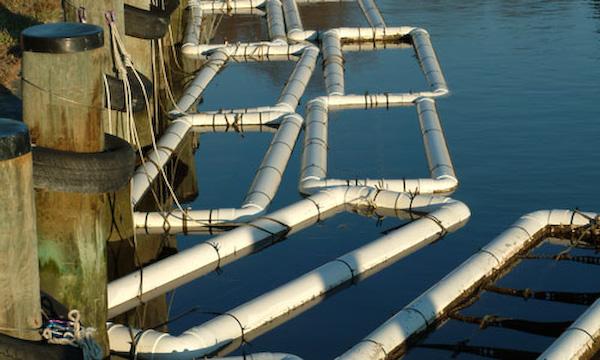Oyster culture is one of the most prominent forms of marine aquaculture in the U.S. In 2011 31 million pounds of oysters were harvestede with a dockside value of approximately $135 million (National Marine Fisheries Service). That is probably a low estimate of the overall value of the oyster because it does account for the ecological value of the fish species that use oyster reefs as a food source and nursery habitat, nor the coastal protection and water-quality services oyster reefs provide. Factoring in both the economic and ecologic value of oyster reefs increases the number into the billions.
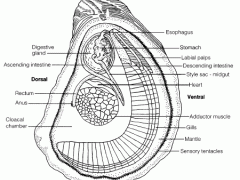 |
|
Oyster Anatomy, Figure:Kennedy et al. 1996 |
Oysters are bivalves; that is, they have two shells made up of calcium carbonate secreted by their mantle tissue that protects their soft bodies from the environment and predators. The oysters’ gills “pump” water to obtain oxygen but also filter particles from the water for the oyster to eat. The food sorted by the gills and labial palps becomes part of a mucous strand that is reeled into the gut known as the crystalline style. The gut is made up of diffuse tissue that is both digestive and reproductive.
Oyster reproduction is cued by temperature changes. When water temperatures change from cold to warm, this change triggers males to release sperm which in turn triggers females to release eggs. Fertilized eggs will float in the water column for ~24 hours and hatch into swimming larvae. The larvae are microscopic and will swim for approximately two weeks until they develop a foot and begin to crawl, searching for a location to set. Once an oyster sets in a location, it cannot move, so finding an ideal location is vital. Oyster larvae exhibit a preference to settle on and around where other oysters are located, creating reefs. This reef formation is based on water quality, current flows, and the availability of a suitable setting material, known as cultch.
The most traditional form of husbandry, or aquaculture, is the practice of moving wild oysters as small juveniles from public bottom to leased areas for grow-out. This practice has gone on for centuries and is still practiced today in many areas such as the Gulf of Mexico and the Chesapeake Bay. In addition, clean oyster shells or other media are planted in areas to attract natural recruitment. However, pollution and overfishing have modified the way oysters are produced to meet the marketplace demand. The Chesapeake Bay once was one of the most prolific oyster grounds in the U.S., but oyster disease, unregulated harvest, and the decline in water quality led to the decimation of the oyster populations. Now with better management in place, including an effort to restore public bottom with suitable substrate, harvesting wild oysters in the Chesapeake Bay is still viable, although not at the level it once was.
The Need for Hatcheries
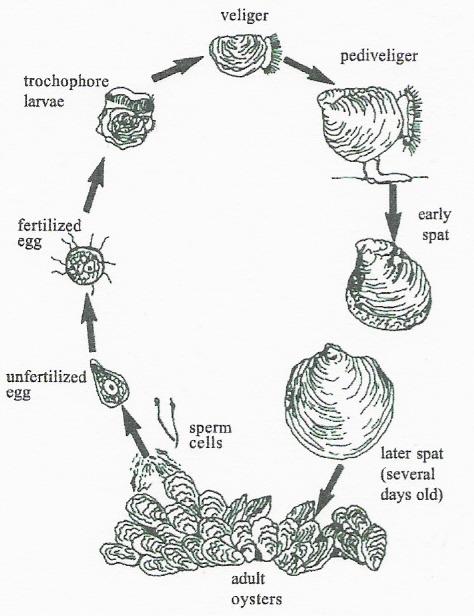 |
|
Oyster Life Cycle, Figure:Wallace et al 2008 |
Meeting the marketplace demand now requires the use of land-based hatchery technology to produce oyster seed in addition to natural recruitment in the wild. This demand has created a new form of oyster aquaculture utilizing hatchery-produced seed.
In some places, such as the Pacific Northwest, almost all the commercially grown oysters are from hatcheries. The hatcheries spawn the oysters and grow the larvae in tanks until they are ready to set. There are two main oyster culture methods to choose from, either single set or remote setting. Single set culture uses a small cultch sized to encourage development of single oysters for the half-shell market; most of this type of oyster seed is grown out in bags, racks, or rafts. Remote setting typically uses large tanks filled with oyster shells as cultch. This cultch can be sprayed onto large open-water leases and the oysters grown out on the bottom.
To produce broods of larvae in the hatchery, sexually mature adult oysters, known as broodstock, must be available. Broodstock can be obtained from the wild or reared as offspring from previous years. A major factor in selecting offspring is genetics. Scientists throughout agriculture have been able to create disease-resistant or faster-growing organisms through the process of selective breeding. Thus, it is very important to consider the genetics of the broodstock that you are using and to know their origin.
After broodstock are selected, the next step is to determine ripeness, or gonadal maturity. Unfortunately, the only way to tell if a group of oysters is ripe is to shuck a few and examine the gonadal tissue to determine if they are ready to be spawned (i.e., if they possess mature gametes) or if they need to be conditioned. Conditioning is the process of manipulating environmental conditions in the hatchery, such as water temperature, to mimic the environmental conditions needed for gonad maturity. This is a common hatchery technique used to extend the production of oysters outside of their natural spawning season. The basic conditioning techniques involve placing broodstock oysters in tanks containing water at ambient temperature and gradually increasing the water temperature and algal supply over several weeks to ripen the oysters. The water temperature and conditions will vary based on the region and location of the oysters.
Although some oyster culturists still rely on the natural spawn in the wild, the oysters produced from hatcheries are produced through either induced spawning or strip spawning.
 |
| Oyster spawning. Photo: Horn Point Oyster Hatchery |
An induced spawn requires that you have ripe oysters that are ready to spawn. Induced spawning is the process of manipulating water temperature to simulate the oysters’ natural spawning conditions. This process is typically done in a spawning table, which is a large, shallow tank set up to circulate warmed seawater from a sump back into the table. This process can take minutes or hours. Sacrificing a male oyster to suspend the sperm in the water can help trigger females to spawn more quickly. Once spawning begins, individual oysters are moved to separate containers of warm seawater to collect the eggs and sperm to keep the eggs from being fertilized until the desired moment. Once the oysters stop spawning, the eggs are collected by pouring the water from containers over a fine mesh screen and are resuspended in clean seawater, when sperm are added to fertilize the eggs. After early development is determined microscopically, the newly formed embryos are placed in tanks at a density of 10 /mL.
- The advantage of induced spawning is the availability to use the same broodstock in subsequent spawns.
- A potential disadvantage is that timing is not under your control; the time it takes for the spawn to initiate and the number of broodstock participating can vary greatly.
Strip spawning involves removing eggs or sperm from shucked, ripe oysters using a scalpel. A small sample of gonadal tissue is smeared on a glass slide and microscopically examined to determine the gender of each oyster. These oysters are then selected for the quality of their sperm or eggs. The stripped gonadal tissue is washed with seawater over a 75-micron screen to remove debris, while the eggs and sperm are collected separately and then mixed similar to the induced spawning method.
- The advantage of a strip spawn is the timing; as long as the oysters are ripe, the spawn takes only as long as it takes to sacrifice the oysters.
- The disadvantage is the broodstock are sacrificed and not available for the future.
Once you have spawned your oysters, the next step is raising them to the desired market size. Newly “hatched” oysters are born with a shell; larval oysters will be about 20 micrometers in diameter with a filamentous velum that allows the larvae to swim. Raising baby oysters, also known as larviculture, requires providing them with proper food and water quality. Food supply is one of the most critical components to any hatchery, and for oysters the food supply is microscopic algae.
The foundation for any hatchery operation is the availability of food. For oysters, this food is microalgae and lots of it. There are two main methods used to culture algae in an oyster hatchery: batch culture and continuous culture.
The batch culture method is the process of culturing algae in increasingly larger volumes. Starting from flask stock cultures and moving up to large tanks, each smaller culture is moved into a larger vessel or tank to achieve the volume of algae required for hatchery operations.
The continuous culture method begins the same as the batch culture method, starting with flask stock cultures and then eventually moving to a larger vessel. Instead of moving cultures to larger vessels or tanks, however, water is continuously added to keep the algae culture in the exponential growth phase. Algae are also harvested continuously so that there is an equal amount of water going in and coming out, thus keeping the culture at a constant volume.
Whether algae are produced through continuous or batch culture, the food supply is a vital part of any hatchery and is the key to successfully conditioning oysters for spawning and larval rearing.
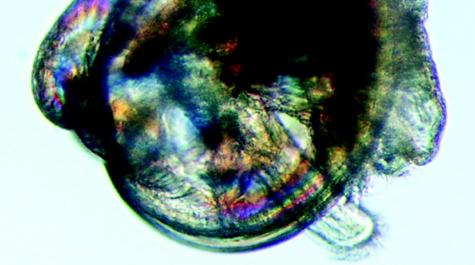 |
| Pictomicrograph of eyed larvae with pseudopod extended. Photo: Michael Congrove and Virginia Institute of Marine Science |
Larviculture, or the raising of baby oysters, is a process that takes about two weeks to 20 days depending on water temperature. Larval oysters are commonly reared in aerated, static cultures from which the larvae are harvested every other day to check survival and growth. The tanks are cleaned and restocked with larvae using progressively lower densities, with algal rations added daily (Table 1). Flow-through larval-rearing systems are more challenging to manage and require more algal production but allow for larvae to be cultured at much higher densities (<100/ml), dramatically increasing larval production. The larvae will be cared for in this manner depending on how long the larvae take to develop an eye spot on their shells and a foot, also known as “eyed” larvae or “pediveligers,” when they are considered competent or ready to set.
| Days after spawn | Larval height (µm) | Sieve size (µm) (diagonal) | Larval density (larvae)/mL | Algal density (cells/mL) |
| 0 | – | 20 | 10 | 20-25,000 |
| 2 | 65 | 35(50) | 5 | 20-25,000 |
| 4 | 100 | 53(75) | 5 | 20-25,000 |
| 6 | 140 | 53(75) | 4-5 | 30-40,000 |
| 8 | 180 | 73(103) | 4 | 50,000 |
| 10 | 220 | 73(103) | 4 | 50,000 |
| 12 | 260 | 100(141) | 3 | 70-80,000 |
| 14 | 290 | 100(141) | 2.5 | 100-150,000 |
Setting
 |
| Initial set on oyster shell. The small black dots are set oyster spat. Photo: Hama Hama Oysters |
 |
| Oyster spat after a few weeks in a grow-out system. |
Once the larvae have a foot, they will begin looking for a suitable substrate for setting. Once they have set on a substrate, known as cultch, the larvae are then considered to be spat or juvenile oysters and will then be moved to either a nursery system or a grow-out system. There are two main methods for setting oysters, depending on how the oysters will be cultured: remote setting and single spat setting. If remote setting is used to develop spat-on-shell oysters, the eyed larvae will be harvested and transported to be set on cultch material. If intensive culture is the desired grow-out method, the oysters will be set in a way to produce single seed traditionally destined for the half-shell or box market.
Setting spat-on-shell can be done at the hatchery or at a remote location by the end user or grower. Containers filled with cleaned oyster shells are placed into large tanks. The types of containers vary from mesh bags to large cages, depending on the volume of production and the level of mechanization. The tanks are filled with filtered seawater, and the eyed larvae are then poured into the tank and allowed to set on the oyster shells. Typically, the system is left closed with only aeration for one to two days to allow the larvae to set. The water can be heated in colder climates or early in the season to allow for a successful set. Then, the system is opened to allow ambient seawater to flow through. The system remains this way for a week or so to allow for spat to grow to a size barely visible to the naked eye. After this time, the tank is drained, and the spatted shells are removed and placed directly on the bottom in open water for grow-out.
Producing single seed oysters for the half-shell market typically takes place in the hatchery, but the larvae can be sold to the end users provided they have the proper equipment. This process requires using micro-cultch, which is finely crushed oyster shells or coral. The cultch is placed on shallow fine mesh screens in shallow tanks of ambient, preferably filtered, seawater. A natural biofilm is allowed to coat the cultch for a day or two prior to adding the larvae. Small volumes of larvae are added and allowed to set on the cultch. The larvae soon outgrow the small fragment to become single oysters. In this method, the small oysters are kept in the hatchery for several weeks and fed a diet of cultured algae before they are released to the nursery system.
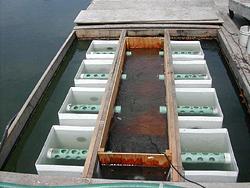 |
| Solar-powered floating upweller system (FLUPSY). Photo: Center for Economic & Environmental Development, Roger Williams University |
Many hatcheries care for their juvenile oysters until they are larger before putting them into a grow-out system. This is to ensure better survival and therefore higher production rates. Several types of nursery systems are used, but the concept is the same. All nursery systems pump ambient seawater to provide a constant flow of water and food to the oysters. The designs and locations may differ — some are floating, like the solar-powered floating upwell system (FLUPSY) shown in the adjacent picture, while some are land-based — but the goal is to allow the oysters to grow approximately an inch (from hinge to bill) as quickly as possible. From the nursery, these seed oysters can either be sold to other commercial producers for grow-out or placed in the company’s own grow-out facilities.
The harvest and movement of oysters to provide food for human consumption date back centuries, to the time of the Romans. The traditional method for culturing oysters was to simply harvest oysters from the bottom using a pair of tongs. The Industrial Revolution led to the use of faster ships that allowed boats to reach oyster reefs more quickly and to the mechanized winch that allowed for dredging reefs, which was much more efficient than a person using tongs. Today, the traditional method of harvesting seed oysters and moving them to private leases for grow-out is still common in the Gulf of Mexico and the Chesapeake Bay. However, in other regions, hatchery-produced oysters now provide the majority of seed oysters for grow-out.
Two common forms of oyster aquaculture use hatchery products: intensive culture (off bottom, containerized) and extensive culture (loose on bottom). Whether obtaining oyster seed as spat-on-shell or as individuals from a nursery system, the ultimate goal is to grow them to a desirable market size. The market size varies from state to state.
Intensive Culture/Cultchless Production
Intensive culture is also referred to as cultchless production because the oyster seed used is single seed (or without cultch). Cultchless production is containerized for predator protection. Containerization varies from floats, bags, rafts, trays, longline systems, racks, and off-bottom cages. Each of these systems has to face factors that can hinder production, such as impacts from storms, fouling organisms, and conflicts with other users of the waters. Growers select the system based on the water quality, wave action, and predation levels at their grow-out location. Intensive culture is more expensive because it requires more labor for gear and product maintenance. However, the end result is a single, more uniform product selling at a higher price in the boxed or half-shell markets.
Extensive Culture/Cultched Production
The second aquaculture production method, extensive culture, is referred to as spat-on-shell or cultched production. This method is more traditional in that oyster larvae from a hatchery are set on clean oyster shells (cultch), planted directly on the bottom, and grown out in clusters. This production method is considered relatively less expensive because once planted, there is little to no maintenance. However, mortality is higher overall for extensive culture, and the product is destined for the shucked market, which generally garners a lower price.
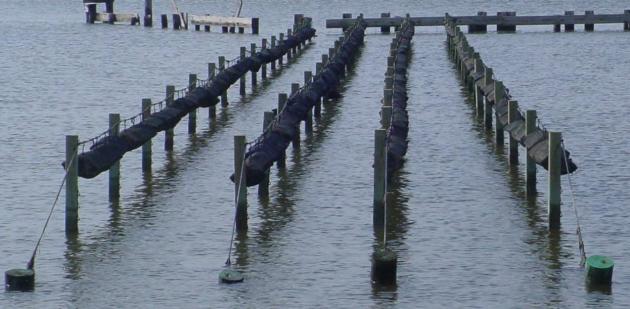 |
 |
| Adjustable longline system being researched in Louisiana. Photo: Vanessa Weldon. | Broodstock held in Taylor floats. Photo: Horn Point Oyster Hatchery |
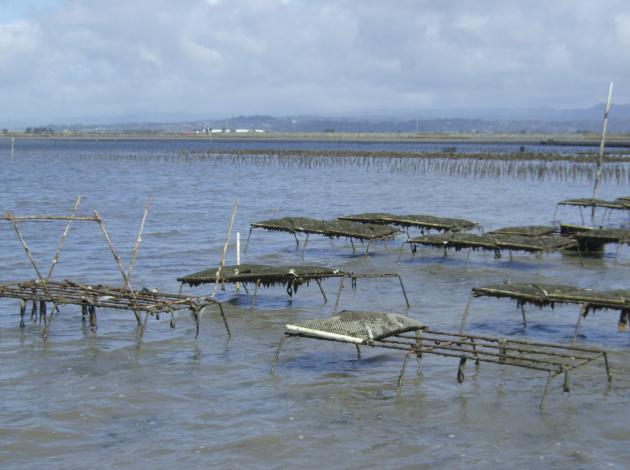 |
 |
| Rack systems. | Oyster condos in Washington. Photo: Hama Hama Oysters |
Triploid Oysters
|
|
|
Diploid oysters (left) and triploid oysters (right) showing differences in summertime marketability. Photo: John Supan, Louisiana Sea Grant |
Oyster aquaculture is similar to traditional agriculture in that seed is selected for improved survival and performance. Two forms of improvements have been used extensively in the oyster industry: disease resistance and polyploidy. Research has developed disease-resistant strains of oysters through the process of selective breeding. Oyster growth and meat quality have been improved through the use of polyploidy, or the development of a triploid oyster. Triploid (3n) oysters have three sets of chromosomes rather than two sets like a wild organism, which are diploid (2n). Triploid organisms are sterile, which means they do not put energy into reproduction. The energy not used for reproduction results in faster growth rates. Because they are non-reproductive, triploids are marketable in the summertime when natural oysters are not, which greatly expands market potential. Many hatcheries provide a seed that is either disease resistant or triploid or both.
The process of developing triploid oysters was begun through the use of chemicals during the fertilization process. The chemical is used to suppress the first polar body in the cell division of fertilized eggs, resulting in a percentage of triploid offspring. However, oysters produced using chemicals are not approved for human consumption. The next step was to use the chemical triploids to produce tetraploid (4n) oysters (organisms with four sets of chromosomes), which are not sterile and can be cross-bred with diploid oysters to make triploids. Fertilization of diploid oyster eggs with sperm from a tetraploid male results in ~100% triploid offspring, with no use of chemicals. The development of the tetraploid technology revolutionized the oyster industry, and many oyster hatcheries now offer triploid oysters.
References
Kennedy, V.S., R. I.E. Newell, and A. F. Eble, Ed. 1996. The Eastern Oyster: Crassotrea virginica. Maryland Sea Grant. 772 pg.
National Marine Fisheries Service (NMFS). Annual Commercial Landing Statistics, Fisheries Statistics.
Wallace, R.K., P Waters, F.S. Rikard. 2008. Oyster Hatchery Techniques. Southern Regional Aquaculture Center. Publication no. 4302.
Oyster Publications
Growing Microalgae to Feed Bivalve Larvae (pdf)
Aquaculture of Triploid Crassostrea ariakensis in Chesapeake Bay: A Symposium Report (pdf)
Aquacultured Oyster Products: Inspection, Quality, Handling, Storage, Safety (pdf)
Aquacultured Oysters (pdf)
Assessment of Future Expansion of Pacific Oyster (Crassostrea gigas) Farming in Northland (pdf)
California Oyster Culture (pdf)
Cross Breeding for Improved Growth and Disease Resistance in the Eastern Oyster (pdf)
Cultivating the Eastern Oyster Crassostrea virginica (pdf)
Diseases of Sydney Rock Oysters (pdf)
Extensive Culture of Crassostrea virginica in the Gulf of Mexico Region (pdf)
Farming the Sydney Rock Oyster (pdf)
Genetic Improvement of the Eastern Oyster for Growth and Disease Resistance in the Northeast (pdf)
History and Impact of MSX and Dermo Diseases on Oyster Stocks in the Northeast Region (pdf)
Lipid Enrichment of Eastern Oyster Broodstock Using Commercially Available Emulsions (pdf)
North Carolina Under Dock Oyster Culture Program (pdf)
Nursery and Growout Methods for Aquacultured Shellfish (pdf)
Opinions of U.S. Consumers toward Oysters: Results of a 2000-2001 Survey (pdf)
Overwintering of Eastern Oysters, Guidance for Small-Scale Growers (pdf)
Oyster Gardening Manual: An Environmental Demonstration Project (pdf)
Oyster Gardening for Restoration and Education (pdf)
Oyster Hatchery Manual: Protocols for North Carolina Oyster Hatchery Operations (pdf)
Oyster Hatchery Techniques (pdf)
Oyster Research and Restoration in U.S. Coastal Waters (pdf)
Producing Oyster Seed by Remote Setting (pdf)
Reestablishing Olympia Oyster Populations in Puget Sound, Washington (pdf)
Reference Manual for Oyster Aquaculturists (pdf)
The Immigrant Oyster (Ostrea gigas), Now Known As the Pacific Oyster (pdf)
